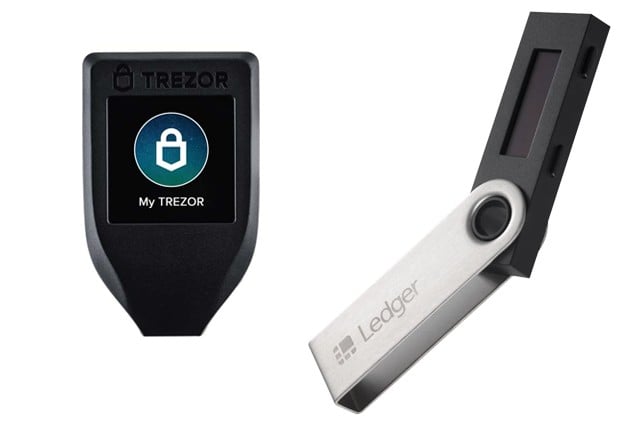When it comes to hardware wallets and crypto security in general, there are no names bigger than Ledger and Trezor. Like Windows and macOS, they are the predominant heavyweights of their respective market, and for good reason. You can’t go wrong with either option.
Both Ledger and Trezor offer top-of-the-line security for your crypto needs and both provide two different price points for consumers to choose from. That said, no two hardware wallets are exactly alike and though both are solid options for anybody looking to keep their crypto safe, there exist key differences that can optimize the crypto experience for the individual user.
Down below, we’ll compare what Trezor and Ledger both have to offer their customers in order to help you determine which hardware wallet is right for you.
Related: Ledger S vs X in 2021
Trezor vs. Ledger 2021

Down below we’ll proceed step-by-step and cover each major domain of consideration or if your attention to help you decide which hardware wallet is right for you. While both families of devices provide top-of-the-line security, there are some major differences in their approach to design, transparency, convenience and backup that may sway users towards either camp. Just remember that you won’t be sorry about purchasing either of the devices.
Pricing

When it comes to pricing, both Trezor and Ledger offer a similar entry point with $59 for the Ledger Nano S and $55 for the Trezor One. At the second entry point for both brands, we see a substantially bigger jump in price with the Trezor Model T selling for $159 and the Nano X for the comparatively cheaper $119.
Thus, price shouldn’t be as much a consideration for users at the first price point as other aspects, considering they’re virtually the same (five bucks shouldn’t be what stands between you and the hardware wallet you really want) while the Trezor Model T has some more work to do in order to justify it’s $40 premium over the Nano X. Down below, as we cover the rest of the key differences between both brands, keep in mind this price difference when considering between the Nano X in the Model T.
Related: Why is Ethereum Dropping? 3 Top Reasons
Security

While there are numerous differences between the two companies in terms of the hardware each wallet provides, all things considered, security is essentially equivalent with both wallets offering similarly adequate levels of protection for most intents and purposes. Both are considered top of the line in the hardware wallet space and users would be hard-pressed to go wrong with either option. Both companies have an impeccable track record of your assets in any case in which there have been demonstrable examples of successful crypto theft have all been shown to be a result of user error.
Ledger wallets rely on something called a secure element chip to maintain security while carrying out their operations. A secure element is a microprocessor: a small chip that essentially functions like a small and lightweight CPU Responsible for interacting with other components and executing instructions. Microprocessors can be found in everything from remote controls to RC car controllers and any other electric device responsible for executing different functions.
A secure element is, to keep things simple, simply a microprocessor with immensely higher levels of security – secure elements are used in things like smartphones, passports, and sim cards where are important data must be maintained. These are the global industry standard for protecting and users’ important data.
Interestingly, on the other hand, Trezor completely rejects the notion of the secure element on an almost philosophical level. This is because secure elements are, by necessity, closed source. Trezor argues that, in the context of crypto security, there is no place for closed-source technology as it can hide back doors and other exploits.
Further, they point out in a blog post dismantling the topic that even though hardware wallet companies that rely on secure elements are unlikely to risk their entire business on a singular theft of their users’ crypto, many governments often pressure chip manufacturers to install back doors inside secure elements anyway— defeating the entire decentralized purpose of cryptosecurity.
Thus, Trezor uses a completely open-source smart security design alongside straightforward microcontrollers to deliver 100% transparent security — and has even launched a new company currently working on a completely open-source answer to the secure element, the Tropic Square.
Thus, both wallets will protect your crypto. Both have been shown to be incredibly effective. Trezor, however, wins out in the spirit of open-source transparency and extra assurance that there are no hidden hang-ups that could put your crypto at risk further down the line.
Related: What is One-Way Hashing?
Design

Aesthetic-wise, many consider the Ledger Nano series to be more appealing. They sport sleek, brushed steel cases over plastic bodies that look like high-quality USB sticks when stowed. On the other hand, the Trezor wallets are wider with a, subjectively speaking, less elegant shape appeal. However, this boils down to differing ratios of form vs. function.
The trade-off between the two is in functionality. While the Trezors are a little bigger and look a little clunkier, they enjoy bigger screens that make them easier on the eyes and easier to read and verify important data like addresses. The screens of the Ledger series are smaller and do not support color. This may not be as big a deal for some, but for those who struggle to read fine print, the Trezor is certainly a better option.
The Trezor Model T also sports a touchscreen which goes some of the way towards justifying the premium customers pay over its competitor, the Ledger Nano X which always requires two hands to operate. With color and touchscreen support, the Trezor wallets win the overall design category in our opinion, since aesthetics are less important in the context of security.
On the other hand, the Ledger series have the aforementioned steel casing that arguably makes them significantly more durable. Both the Trezor One and the Model T are plastic, and though durable in their own right obviously can’t compete with steel. Thus, where durability is concerned, the Ledger series are the clear winners via the material of the naked device— though it should be mentioned that Trezor customers have a wide variety of cases to choose from, going a long way towards closing the durability gap. But those cost money.
Related: What is a dApp?
Crypto Support

When it comes to crypto support, the Ledger series narrowly edges out Trezor in the total number of tokens that can be stored on the device. While both companies provide support for over 1000 cryptocurrencies, for many crypto users this distinction is meaningless considering how few ever put money into hundreds of cryptocurrencies simultaneously. It’s the popular tokens that carry the most weight.
However, critically, the Trezor One does not support a few major cryptocurrencies, namely: Cardano ADA, Ripple, Monero, and EOS. To use these currencies, Trezor customers have to opt for the Trezor Model T at $159, while the Ledger Nano S provides support at almost 1/3 of the price. Plus, if you’re not willing to pay a premium for the Model T but trade in any of these currencies, your best choice is obviously the Ledger Nano S.
Features

Both wallets offer users the ability to host multiple accounts on the same hardware wallet, differentiated by a different password that is entered upon use. This allows users to circumvent coercion and blackmail attempts by storing less valuable accounts on the same wallet without it being readily apparent. There is, however, one critical difference in terms of security in the way this feature is handled — on both Ledger wallets and the Trezor Model T, this is a pin code entered directly into the device.
On the other hand, the Trezor One wallet requires users to enter this password via the keyboard of the PC it is connected to, meaning it can be read by a keylogger. While this latter aspect of the Trezor won’t on its own compromise your security on its own — not at all – it’s still an important consideration worth mentioning and is a feather in Ledger’s cap at the first price point.
The Trezor Model T ups the ante with a unique recovery feature known as Shamir backup that can help you reconstruct your wallet in the event it is lost. Typically, hardware wallets come with a multi-word passphrase that can be used to restore the wallet in case it is lost or destroyed. This passphrase is often kept, like a paper wallet, offline in a secure location. It does however pose the added risk of being a weak point in your overall security in case someone gets their hand on it.
Related: Trezor Model T: What Is Shamir Backup ?
On the other hand, the Shamir backup uses multiple “recovery shares” That, when used together like individual passphrases, restore your account. For example, you can set a “7/10” Shamir backup scheme in which 10 sets of 24-word passphrases are generated. Each share of 24 passwords can be either kept in a secure location or distributed among trusted others, called upon only when needed. If you set your threshold to seven out of 10, you need to input at least seven of the 10 recovery shares to restore your wallet – that way an attacker would need to find seven, not just one, items to gain access to your wallet.
Conclusion

At the end of the day, it seems that at the first price point the Ledger Nano S pretty handily outdoes the Trezor One. It’s slicker, more durable, supports more currencies and supports on-device password input. But it’s not a complete blowout — users more attracted to the larger screen of the Trezor would do well to opt for it and save 5 bucks at the same time. On the other end of the spectrum, we have the Ledger Nano X versus the Model T.
If the matter of open-source technology and transparency isn’t an issue, we would recommend the Nano X in the context of saving 40 dollars (almost enough to purchase a backup Nano S) but, if the price isn’t an issue, the Trezor Model T seems like the single-most comprehensive device on the market with Shamir backup, a touchscreen, and color support. The only situation in which price isn’t an object but we would still recommend the Nano X over the Model T is for especially active traders who need to be able to trade on the go.
Otherwise, as we said at the start, in terms of raw security any of the Trezor and Ledger wallets will be more than adequate for keeping your crypto secure.
Still on the fence about which hardware wallet to go for? Let us help. Feel free to reach out to us with any questions you might have down in the comments below! We’re here to help.
RELATED
- Nerdschalk Explains: What is Proof of Stake? And how is it vs Proof of Stake
- Nerdschalk Explains: What is Proof of Work?






Great review of the Trezor vs Ledger. With that said, I’m interested in holding ADA and Filecoin and looks like the Trezor is the only option for ADA. Any suggestions or work arounds?
Trezor One does not support ADA. Trezor Model T does support ADA. Both Ledger S and X support ADA.